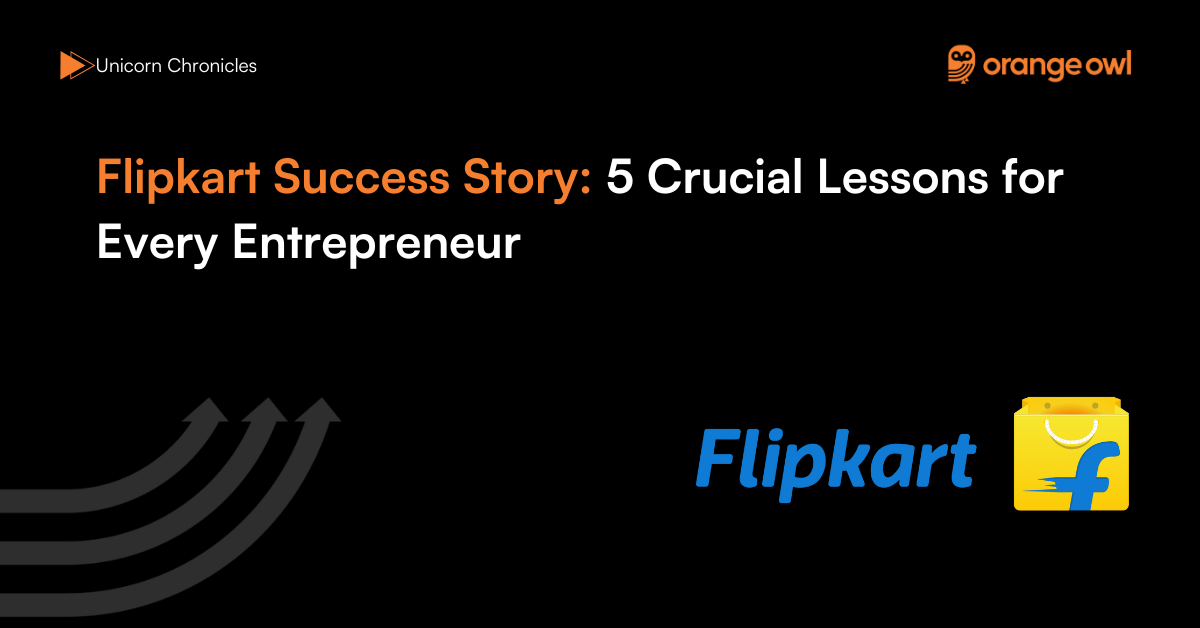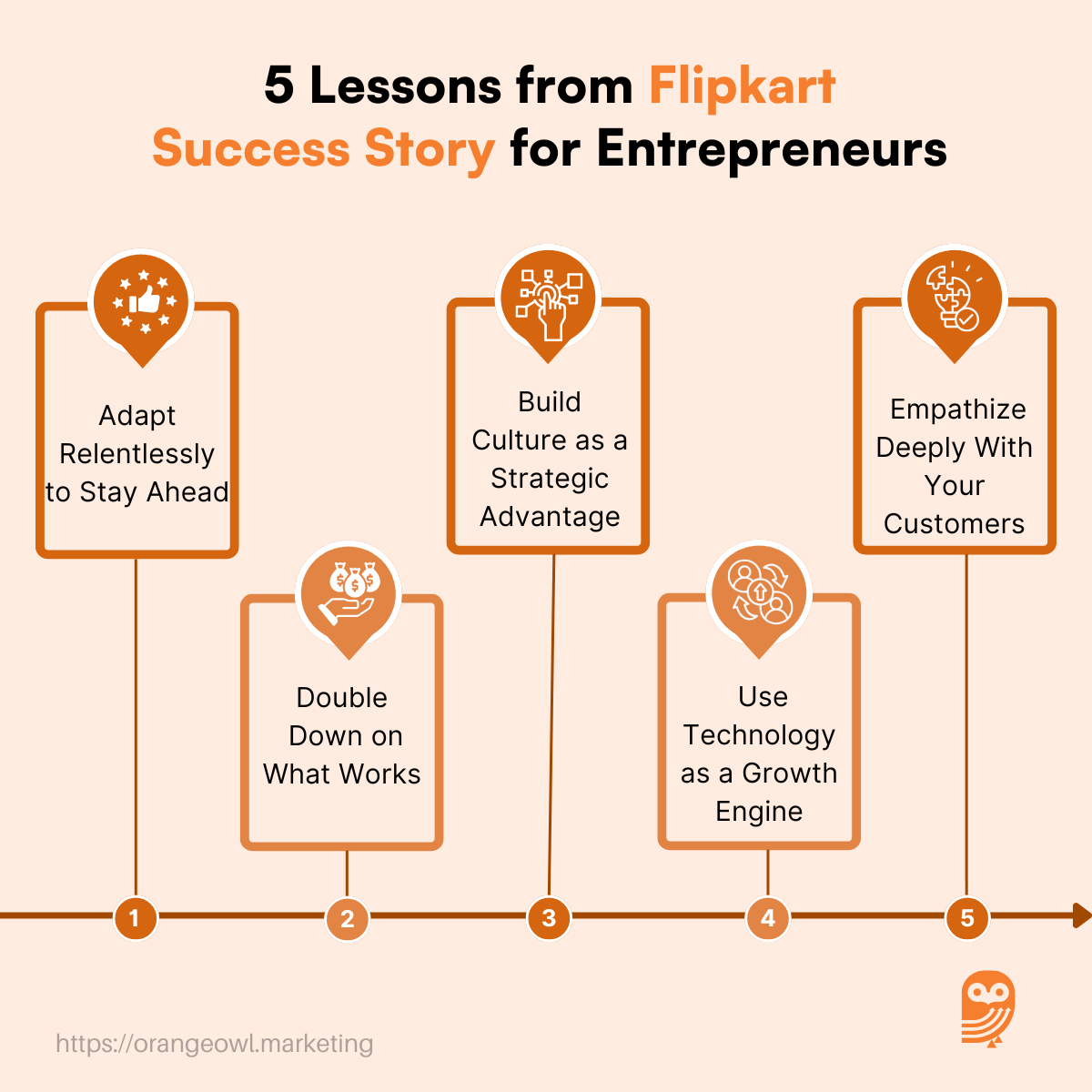Flipkart Success Story: 5 Crucial Lessons for Every Entrepreneur
Vivek Goel
May 23, 2025

Table of Contents
Introduction
Founded in 2007 by Sachin Bansal and Binny Bansal, two former Amazon employees and IIT Delhi graduates, Flipkart began as a bold experiment to bring online retail to India—starting with a single product category: books. Operating out of a modest 2BHK apartment in Bengaluru, the co-founders personally handled everything—from coding the website to customer service and delivery. This hands-on approach and deep understanding of Indian consumer behavior laid the foundation for what would eventually become one of India’s most iconic startups.
What started as a small-scale operation quickly gained traction. Flipkart won over Indian consumers by addressing key barriers to online shopping: unreliable delivery, limited payment options, and poor customer service. They introduced industry-first innovations such as Cash on Delivery (CoD) and easy returns, which played a pivotal role in building trust among Indian shoppers who were still skeptical about e-commerce. These moves didn’t just shape Flipkart’s growth—they reshaped the entire Indian e-commerce landscape.
Over time, Flipkart diversified its product offerings, ventured into mobile phones, fashion (with Myntra and Jabong acquisitions), and eventually established itself as a full-scale marketplace competing head-on with global giants like Amazon. Its relentless focus on localization, customer experience, and strategic investments in technology helped it become a household name.
As of FY24, Flipkart reported ₹17,907 crore in marketplace revenue, marking a 21% year-over-year growth, while successfully narrowing its losses by 41% to ₹2,358 crore. These numbers signal not just financial recovery, but a renewed strategic clarity and operational discipline. Even in a hyper-competitive market, Flipkart has managed to retain its edge through resilience, agility, and a clear focus on what truly matters: delighting customers.
In the words of co-founder Sachin Bansal:
“We wanted to redefine how India shops. But more importantly, we wanted to solve real problems for real people.”
Today, Flipkart stands not just as an e-commerce leader, but as a case study in Indian entrepreneurial grit, innovation, and the long game of building a business that scales sustainably.
Origin Story
Flipkart’s journey began in 2007 when Sachin Bansal and Binny Bansal, both alumni of IIT Delhi and ex-Amazon employees, decided to take a bold leap into India’s fledgling e-commerce market. At the time, online shopping in India was in its infancy, marred by consumer distrust, limited internet penetration, and logistical challenges. Despite these hurdles, the Bansals identified a massive gap—and an equally massive opportunity—in making shopping more accessible, convenient, and trustworthy for Indian consumers.
Starting with a niche focus on books, Flipkart’s early days were marked by intense hustle and a hands-on approach. The founders packed and delivered books themselves, ensuring every order met customer expectations. This obsession with the customer experience became Flipkart’s cornerstone. Rather than chasing growth for its own sake, Flipkart concentrated on solving the real pain points that Indian consumers faced—such as failed deliveries, lack of online payment trust, and poor customer support.
As Sachin Bansal reflected in an interview:
“We wanted to build something that would change the way people shop in India.”
That vision drove a series of pioneering innovations: Cash on Delivery, easy return policies, and robust customer service—each of which built consumer trust and became e-commerce standards across India. By solving India-specific challenges with empathy and ingenuity, Flipkart created a scalable blueprint for digital retail in a complex market.
Business Landscape and Challenges
As Flipkart scaled rapidly, so did the complexities of the market. The e-commerce boom attracted deep-pocketed global players like Amazon, who entered India in 2013, intensifying the battle for market share. Meanwhile, domestic competitors like Snapdeal were also vying for consumer attention. The competition ignited a high-stakes race for growth, fueled by aggressive pricing, logistics expansion, and heavy marketing spends.
To defend and expand its turf, Flipkart pursued several key strategic acquisitions. In 2014, it acquired Myntra and later Jabong, consolidating its dominance in the online fashion segment—one of India’s most lucrative and competitive verticals. It also invested in tech infrastructure and supply chain innovation, with initiatives like Ekart, its in-house logistics arm, giving it a competitive edge in last-mile delivery.
However, the fast-paced growth brought growing pains. Operational inefficiencies began to surface, particularly in inventory management and order fulfillment. Mounting losses and leadership churn led to concerns about sustainability. Flipkart faced a critical juncture where business as usual was no longer viable.
Recognizing this, the company began a major organizational restructuring, streamlining processes, revamping leadership, and doubling down on data-driven decision-making. It reoriented its focus on profitability, customer retention, and long-term value creation rather than short-term growth metrics.
These measures paid off. As per FY24 filings, Flipkart recorded ₹17,907 crore in marketplace revenue, up 21% year-over-year, and narrowed its losses by 41% to ₹2,358 crore. The turnaround validated the Bansals’ early ethos: build for the long-term, not just the next funding round.
Growth Strategies
Flipkart’s resurgence in the highly competitive Indian e-commerce market can be credited to a series of deliberate, forward-thinking strategies that emphasized scalability, efficiency, and customer value. One of the pivotal shifts was Flipkart’s move towards an asset-light model, where the platform empowered sellers to handle their own fulfillment. This strategic decision significantly reduced the company’s overhead costs and enabled rapid, sustainable growth without the financial strain of maintaining large inventories or warehouses.
At the heart of Flipkart’s operational excellence was a deep investment in technology. The company harnessed the power of machine learning and automation to enhance every layer of its ecosystem—from intelligently optimizing product listings based on user behavior, to refining its logistics operations for faster, more reliable deliveries, to tailoring recommendations that increased both customer satisfaction and conversion rates. This tech-driven efficiency allowed Flipkart to stay agile in an environment where expectations were constantly evolving.
In addition, Flipkart forged direct relationships with manufacturers, bypassing traditional middlemen and thereby ensuring both cost efficiency and product quality. This approach not only improved margins but also reinforced Flipkart’s positioning as a value-driven platform—offering genuine products at competitive prices, a critical factor in building trust with Indian consumers.
Perhaps equally transformative was Flipkart’s internal cultural reset. The company consciously cultivated a work environment centered on transparency, mission clarity, and fast execution. Leadership made sure every team, from engineering to marketing, was aligned with the broader vision: creating an inclusive and accessible e-commerce experience for every Indian. This unity of purpose was critical in navigating high-pressure situations and in maintaining focus during times of industry flux.
These combined strategies did more than just stabilize the business—they positioned Flipkart as a mature, resilient force in Indian e-commerce, capable of scaling with purpose while remaining grounded in its mission to serve the Indian customer.
Marketing Strategy
Flipkart’s marketing strategy has always stood out for its deep cultural relevance and regional authenticity. Rather than adopting a one-size-fits-all national campaign model, Flipkart prioritized localization—building distinct campaigns that spoke to the diverse cultural fabric of India. This included crafting advertising in regional languages and tailoring narratives to align with the aspirations of consumers in Tier 2 and Tier 3 cities, where digital adoption was booming but still rooted in traditional values.
The company also embraced micro-influencer marketing long before it became a buzzword. By collaborating with regional content creators and influencers, Flipkart created powerful grassroots connections with its audience. These influencers brought a sense of trust and relatability that traditional celebrity endorsements often lacked, especially in smaller cities and towns where personal rapport and community influence carry weight.
Flipkart’s social media strategy echoed this tone of authenticity. The brand filled its channels with relatable, often humorous content—from regional memes to interactive polls and topical moment marketing. Instead of pushing products aggressively, Flipkart focused on sparking conversations and evoking everyday experiences, making the brand feel less like a corporation and more like a friendly neighborhood store with a modern touch.
As Binny Bansal once remarked,
“Understanding our customers’ needs and preferences has always been at the heart of our marketing efforts.”
This deep-seated customer empathy translated into loyalty, engagement, and a strong brand identity that resonated across the socioeconomic spectrum. Through these locally attuned, customer-first initiatives, Flipkart not only expanded its market but also became a household name in Indian e-commerce.
5 Crucial Lessons for Every Entrepreneur
1. Adapt Relentlessly to Stay Ahead
Flipkart’s journey from a humble online bookstore to one of India’s largest e-commerce platforms reflects the importance of relentless adaptation. Founders Sachin and Binny Bansal quickly realized that India’s retail landscape was evolving rapidly, and so were customer expectations.
By constantly experimenting—expanding categories, introducing innovations like cash-on-delivery, and reworking their supply chain—the company showed how agility can outpace even the fiercest competition. Entrepreneurs must be willing to iterate, pivot, and reinvent to stay relevant.
2. Double Down on What Works
While Flipkart explored many new verticals during its growth phase, its biggest wins came from refining its core strengths. By focusing on what it did best—seamless logistics, a user-friendly interface, and trustworthy service—it carved out a distinct brand in a crowded market.
This teaches entrepreneurs an essential truth: excellence in your core offering will always outperform average performance across many fronts. Focus and consistency are powerful business levers.

3. Build Culture as a Strategic Advantage
Culture isn’t just about company values—it’s the glue that holds a team together through highs and lows. Flipkart fostered a resilient and transparent workplace that prioritized speed, ownership, and mission clarity.
When the company faced internal restructuring and external competition, this strong culture provided stability. Startups should invest in cultivating a workplace ethos that empowers people and promotes collective accountability.
4. Use Technology as a Growth Engine
For Flipkart, technology was never an afterthought—it was a growth engine. From personalized shopping recommendations to backend inventory automation, tech was embedded in every layer of the business.
By leveraging data science and AI, Flipkart improved both user experience and operational efficiency. Entrepreneurs should treat tech as a strategic pillar, capable of unlocking scale and insight that manual operations cannot match.
5. Empathize Deeply With Your Customers
What truly set Flipkart apart was its grassroots-level understanding of Indian shoppers. From launching vernacular campaigns to adapting payment methods for less-banked consumers, Flipkart listened intently to its audience.
This deep empathy helped the company earn loyalty in Tier 2 and Tier 3 cities—markets that many competitors overlooked. For entrepreneurs, the big takeaway is: solve real problems for real people, and customers will reward you with their trust.
Conclusion
Flipkart’s journey from a small apartment in Bengaluru to becoming one of India’s largest e-commerce platforms is a story of resilience, reinvention, and relentless focus on the customer. It is not just a tale of business growth but one of navigating challenges, embracing change, and staying anchored to core values. The company’s willingness to pivot, invest in technology, and remain grounded in the needs of everyday Indians enabled it to transform not just its own destiny but also redefine online shopping in India.
As Sachin Bansal aptly said:
“Success is a journey, not a destination. It’s about evolving and staying true to your mission.”
For aspiring entrepreneurs, Flipkart serves as more than just a success story—it’s a blueprint for building a business that is both innovative and impactful. In an age where disruption is the norm, Flipkart reminds us that clarity of purpose, adaptability, and a deep understanding of one’s audience are the cornerstones of lasting entrepreneurial success.


